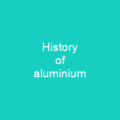Aluminium: The Versatile Metal with a Rich History
Imagine a world where a single element can transform from a dull grey metal to a shiny, reflective surface that mirrors the beauty of silver. That’s aluminium for you! With its unique properties and widespread applications, it’s no wonder this element has captured the imagination of scientists, engineers, and everyday users alike.
Properties and Applications
Aluminium (or aluminum) is a chemical element with symbol Al and atomic number 13. It’s lightweight, malleable, and highly reflective, making it an ideal material for various industries. Its ability to form a protective oxide layer on its surface when exposed to air means that aluminium can withstand corrosion from oxygen, water, or dilute acid. This makes it suitable for use in numerous applications ranging from household items to aerospace engineering.
From Ancient Times to Modern Industry
The history of aluminium is as fascinating as the element itself. Its usage dates back to ancient times when alum was used as a dyeing mordant and city defense material. However, it wasn’t until 1825 that the discovery of aluminium was announced by Hans Christian Ørsted. The first industrial production began in 1856 with Henri Etienne Sainte-Claire Deville’s process, which revolutionized how we produce this versatile metal.
Production and Processing
The journey from bauxite to aluminium involves a complex series of steps. Bauxite rock is extracted and processed into alumina using the Bayer process. This alumina is then converted to aluminium through the Hall–Héroult process, which requires significant amounts of energy. Anodes made of carbon are used in the electrolysis cell, with cathodes made from anthracite. The process produces liquid aluminium that is tapped off and cast into blocks for further processing.
Environmental Impact
The production of aluminium poses challenges to the environment due to greenhouse gas emissions, primarily perfluorocarbons and sulfur dioxide. However, recycling plays a crucial role in reducing these impacts. Recycling involves melting scrap, which requires only 5% of the energy needed to produce from ore. This makes it an environmentally friendly option that can significantly reduce waste.
Health and Safety
While aluminium is generally safe for everyday use, high doses can cause adverse effects such as vitamin D-resistant osteomalacia, erythropoietin-resistant microcytic anemia, central nervous system alterations, and more. Dietary exposure in Europeans averages 0.2–1.5 mg/kg/week but can be higher due to various factors.
Conclusion
In conclusion, aluminium is a remarkable element with a rich history and diverse applications. From its discovery to modern industrial production, this metal continues to shape our world in countless ways. Its unique properties make it indispensable across multiple industries, while recycling efforts help mitigate environmental impacts. As we continue to innovate and explore new uses for aluminium, one thing remains clear: this versatile element will undoubtedly play a significant role in the future of technology and industry.

You want to know more about Aluminium?
This page is based on the article Aluminium published in Wikipedia (retrieved on March 12, 2025) and was automatically summarized using artificial intelligence.







